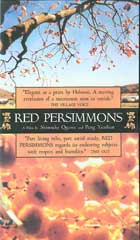
Red Persimmons 2001
Distributed by First Run/Icarus Films, 32 Court St., 21st Floor, Brooklyn, NY 11201; 800-876-1710
Produced by Imagica
Directed by Shinsuke Ogawa and Peng Xiaolian
VHS, color, 90 min.
Sr. High - Adult
Agriculture, Area Studies, Japan, Asian Studies
Date Entered: 04/14/2005
Reviewed by Sheila Intner, Professor, Graduate School of Library & Information Science, Simmons College GSLIS at Mt. Holyoke, South Hadley, MAMost Americans and urbanites elsewhere tend to forget where the food they eat comes from, and it is no surprise, since they first see it on supermarket shelves neatly packaged in portion-controlled amounts intended for the nuclear families that shop there. Today, smaller numbers of people actually see crops growing, being harvested and prepared by hand, before they become part of the retail food chain. Perhaps that is why this documentary is so fascinating, although it is not the only reason. On the most obvious level, it records the process of growing persimmons and preparing them for the market beyond their home territory in northern Japan. On a deeper level, it documents a lifestyle that has its own philosophy, values, and virtues.
Filmmaker Shinsuke Ogawa began filming Red Persimmons in the early 1980s as part of a larger project to document traditional rural Japanese life, which followed practices established long ago. He believed these communities were destined to disappear before long, like candles burning down to the end and quietly going out with a small puff of smoke. Ogawa did not live to complete his task with the persimmon growers, but a pupil, Peng Xiaolian, finished the work, remaining true to his teacher’s low-key informal, natural, and artistic style.
The film takes us to Kaminoyama, where, according to the inhabitants, the soil and climate are perfect for growing the best persimmons. Using time-lapse photography, we see the fruit grow and ripen on the trees, watch as old men climb rickety ladders to pick the fruit, taking care to leave some on each tree as an offering to its creator. The fruit is taken home where families pitch in to sort, trim, peel, and braid the fruit securely onto strong ropes. The ropes are hauled outdoors to drying racks and hung in the wind until they begin showing a sugary glaze, then placed over charcoal braziers until the drying process and sugar coatings are complete.
The most time-consuming step is peeling each of the thousands of individual fruits, one at a time. Machines to speed it up were invented decades ago. Villagers are interviewed who each claim to be the inventor, including the bicycle shop owner (this reviewer’s pick for the honor). Farmers in nearby villages and persimmon dealers in larger towns make similar claims. Maybe each is the “real” inventor in his little circle. They all share the lament that young people are leaving the villages and only the old people continue doing the backbreaking work. At the end of the film, we see brokers buy the crop and sell it to wholesalers who package it - again, handling the fruit by hand - and sell it to retailers who can, then, sell it to people like us.
Red Persimmons is thoughtfully conceived and beautifully filmed. It is all in Japanese, even the credits, but good English subtitles supply the meaning. It not only offers facts about persimmon growing, but insights into the inner workings of traditional Japanese rural life.